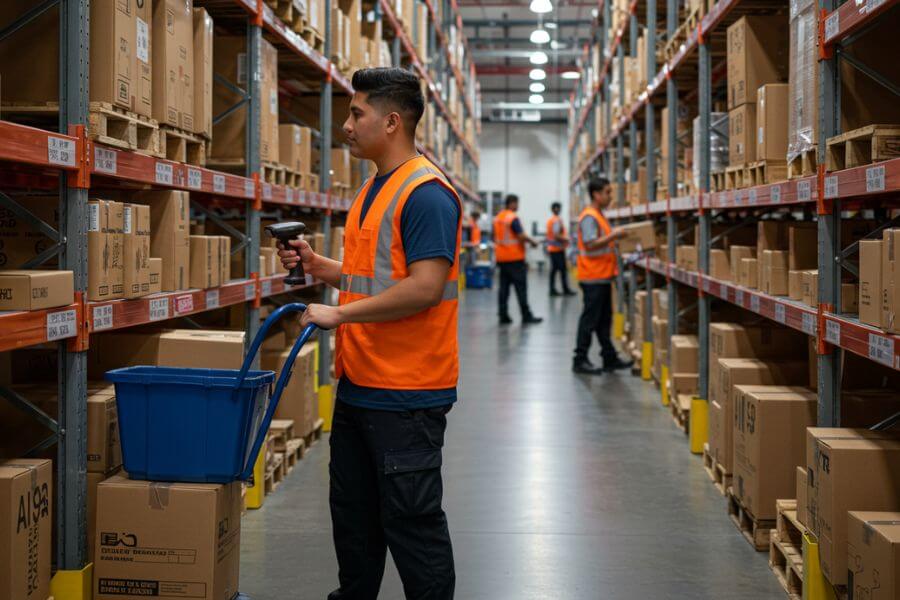As ecommerce continues to redefine customer expectations around delivery speed and accuracy, businesses are under growing pressure to streamline their order fulfillment operations. The efficiency of a warehouse can directly impact everything from operational costs to customer satisfaction and brand reputation. Among the many fulfillment strategies used today, zone picking stands out as one of the most efficient and scalable solutions for high-volume warehouses.
This comprehensive guide explores what zone picking is, how it works in practice, its benefits and challenges, how it compares with other picking methods, and how you can implement it effectively to transform your fulfillment process.
What is zone picking?
Zone picking is a warehouse order picking strategy in which a warehouse is divided into distinct sections or “zones,” and each worker (or picker) is assigned to only one of these zones. Rather than a single picker traveling the entire warehouse to collect items for an order, several workers collaborate, each responsible for picking the items in their assigned area. Once all parts of the order are collected, the items are consolidated before they are packed and shipped.
This method functions much like an assembly line, with each picker handling a specific step (or zone) in the process. It’s particularly effective in larger warehouse environments with broad SKU catalogs, where walking time and inefficiency can otherwise drain productivity and profits.
Zone picking can be executed in sequential, simultaneous, or parallel configurations, depending on how orders are routed through zones and how fast consolidation occurs. It’s also frequently paired with automation to maximize throughput.
How does zone picking process work?
Implementing zone picking involves several structured steps that bring order and speed to the fulfillment process. Here’s a deeper look at how it works from start to finish:
Step 1: Order segmentation
When a customer places an order, the warehouse management system (WMS) breaks it down into individual line items and identifies the storage location of each item. Each item is then mapped to its designated zone.
Step 2: Zone assignment
Each warehouse employee is assigned a specific zone and becomes responsible for picking all SKUs located within that area. This leads to deep familiarity with products and shelving layouts, resulting in increased speed and fewer errors.
Step 3: Coordinated picking
There are multiple approaches to how the picking occurs:
- In sequential zone picking, the order travels from one zone to the next in a fixed path. The picker in Zone A picks their items and then hands the tote off to Zone B, and so on.
- In simultaneous zone picking, all zones pick their assigned items at the same time. These items are then brought together at a central consolidation station.
- In parallel zone picking, the order is split across zones and processed separately before being merged during packing.
The picking method you choose depends on your operation’s size, layout, and tech infrastructure.
Step 4: Consolidation and packing
After each zone has picked its portion of the order, the items are transported to a central location for consolidation. This is where the full order is reviewed, verified, and packed before shipping.
What are the benefits of zone picking?
Zone picking is designed to optimize fulfillment speed, reduce travel time, and improve accuracy, all of which contribute to better warehouse performance and customer satisfaction. Let’s explore its benefits in more detail:
Significant reduction in travel time
In traditional picking systems like discrete picking, workers may walk miles each day to gather items from across the warehouse. Zone picking cuts this travel dramatically because pickers remain in their dedicated areas. This reduces time wasted walking between storage racks and speeds up the overall picking process.
Improved accuracy and familiarity
When workers specialize in specific zones, they become intimately familiar with the SKUs in their area. This repetition reduces picking errors, minimizes confusion, and increases confidence among staff, especially helpful during seasonal demand spikes or when onboarding new employees.
Better labor utilization and productivity
Zone picking allows businesses to allocate labor where it’s most needed. Busy zones with high-order volumes can be staffed with more pickers, while quieter zones require fewer workers. This intelligent distribution of labor leads to better resource utilization and higher overall throughput.
High scalability
One of the greatest strengths of zone picking is its adaptability. As your business grows and SKU count increases, you can expand your warehouse by adding more zones or rebalancing labor assignments without overhauling your entire process.
Seamless integration with automation
Zone picking is highly compatible with warehouse automation. From conveyor belts that move order totes between zones to pick-to-light systems that guide workers visually, automation tools amplify the benefits of zone picking. Even robotic systems like autonomous mobile robots (AMRs) can be deployed to move products between zones or to the packing station, increasing speed and reducing manual workload.
5 ideal use cases for zone picking
Zone picking isn’t the right fit for every business, but it’s highly effective in several scenarios. Here’s when you should strongly consider it:
- Large or complex warehouse layouts: If your team spends too much time walking, zone picking can slash travel time dramatically.
- High SKU variety: The more diverse your product inventory, the more beneficial it becomes to group similar products into logical zones.
- Heavy daily order volume: If you’re dealing with hundreds or thousands of orders a day, zone picking improves flow and reduces order cycle time.
- Multi-shift operations: With clearly defined zones, shift transitions become smoother and more structured, reducing errors during handoffs.
- Ecommerce or B2C fulfillment: These businesses typically have smaller, multi-item orders that benefit from fast and accurate zone-based picking.
Zone picking vs. other picking methods
To fully understand the strengths of zone picking, it helps to compare it to other common picking strategies.
Zone picking vs. discrete picking
In discrete picking, one worker completes the entire order alone, retrieving all items across the warehouse. While it’s simple to manage and easy to understand, it becomes inefficient in larger facilities where travel time becomes a burden. Zone picking significantly reduces walking and breaks orders into manageable parts.
Zone picking vs. batch picking
Batch picking involves one picker gathering items for several orders at the same time. It’s great for efficiency when orders share similar SKUs but can lead to congestion in high-traffic areas. Zone picking is more structured and limits cross-zone traffic.
Zone picking vs. wave picking
Wave picking schedules order fulfillment around delivery time windows. It’s ideal for aligning picking with outbound shipping but doesn’t inherently reduce walking distance. Zone picking focuses more on operational layout and task division, but the two methods can be used together for maximum efficiency.
What are the common challenges of zone picking?
Despite its advantages, zone picking isn’t without hurdles. Anticipating these challenges can help you prepare better:
Order consolidation bottlenecks
Because each order is picked in segments, delays in one zone can hold up the entire fulfillment process. If Zone C is slow while Zones A and B finish quickly, the entire order must wait. Balancing workloads across zones is key.
Higher implementation costs
Setting up zones often requires changes to warehouse layout, investment in technology (like WMS or conveyors), and training staff. These upfront costs may deter small operations, even if long-term ROI is positive.
Dependence on coordination
Since multiple people touch each order, poor communication or system errors can lead to delays or incomplete shipments. That’s why integrating systems and clear SOPs are crucial.
Ongoing training and maintenance
As staff rotate or new workers are hired, you’ll need to maintain consistent training programs to ensure zone responsibilities are understood and followed.
What are the best practices for implementing zone picking?
Successfully adopting zone picking requires more than just rearranging warehouse space; it’s about building a structured, data-driven system that integrates people, processes, and technology. To ensure smooth implementation and long-term efficiency, here are the most important best practices to follow:
1. Conduct a detailed warehouse analysis
Before you divide your warehouse into zones, perform a thorough analysis of your current layout, SKU distribution, order profiles, and picking volumes. Look for patterns in your data, such as high-frequency SKUs, heavy items, or products that are frequently picked together. This information will help you design zones that make operational sense and minimize travel time.
Your goal is to segment your warehouse in a way that balances both workload and logic. For example, grouping fast-moving items into a dedicated zone can prevent congestion, while assigning bulky or oversized items their own area ensures safer and faster handling.
2. Design zones based on SKU velocity and item characteristics
Not all zones should be created equal. When designing your zones, consider SKU velocity (how often each item is picked), product size, weight, storage requirements, and even seasonal demand shifts. High-velocity items may require larger zones or more labor, while infrequently picked items can be grouped together in lower-priority areas.
Additionally, think about the ergonomics and flow within each zone. Ensure there’s enough space for safe movement, proper shelf access, and, if applicable, room for automation systems like conveyor belts or pick carts.
3. Optimize labor distribution strategically
One of the biggest mistakes in zone picking is failing to assign labor proportionally. An imbalanced workload between zones can create bottlenecks—orders can only move as fast as the slowest zone.
Use data from your WMS to understand pick rates per zone and allocate staff accordingly. During peak periods, be flexible enough to move labor resources between zones based on real-time demand. Cross-training your staff so they can operate in multiple zones when needed is also a smart way to maintain agility.
4. Leverage a robust warehouse management system (WMS)
A reliable WMS is essential for coordinating zone picking. It should be capable of automatically breaking down orders, routing pick tasks by zone, tracking progress in real time, and guiding consolidation workflows.
Invest in a system that integrates seamlessly with barcode scanners, mobile picking devices, pick-to-light systems, or even robotics if you use them. Your WMS should also provide actionable reporting so you can track KPIs like pick time, accuracy rates, and zone performance over time.
5. Standardize and document operating procedures
For zone picking to be effective, consistency is key. Develop clear Standard Operating Procedures (SOPs) for every aspect of the process, from how picks are assigned and transferred between zones to how issues like damaged inventory or out-of-stock items are handled.
Document these procedures and train all staff accordingly. Use visual signage in each zone to reinforce processes, and conduct regular refresher training to maintain quality and compliance, especially when onboarding seasonal workers or expanding teams.
6. Implement real-time communication and visibility
Smooth zone coordination depends on real-time communication. Equip your team with handheld devices, headsets, or mobile apps that allow them to stay updated on pick tasks, order status, and exception handling.
Ensure your WMS dashboard provides warehouse managers with a live view of zone progress, bottlenecks, and labor allocation. This visibility makes it easier to make data-backed decisions and intervene quickly when issues arise.
7. Monitor, measure, and continuously improve
Once your zone picking system is in place, ongoing performance monitoring is essential. Use metrics such as:
- Order cycle time (from order release to packing)
- Pick accuracy rate (number of correct picks vs. total)
- Zone productivity (items picked per hour per zone)
- Labor utilization (how efficiently labor is deployed)
Use these insights to adjust zone configurations, rebalance workload, revise SOPs, or invest in new technology as needed. Periodically review zone layouts, especially if you’ve added new products or changed storage methods.
8. Plan for scalability and flexibility
Design your zones not just for today’s operations, but with future growth in mind. Ensure your layout can accommodate more SKUs, larger volumes, or new product categories. Avoid rigid designs that can’t evolve without major overhauls.
Flexible infrastructure, modular shelving, and adjustable automation tools can help your warehouse adapt as your business expands. Zone picking works best when it evolves with your operations, not when it’s treated as a one-time setup.
5 real-world examples of zone picking
Understanding how leading companies use zone picking in their fulfillment operations can provide valuable insights into its practical application and impact. From global ecommerce giants to specialized third-party logistics providers, many businesses have adopted zone picking to scale operations, reduce errors, and meet rising consumer expectations.
Amazon fulfillment centers
Amazon is perhaps the most iconic example of an advanced fulfillment operation using zone-based strategies. In its massive fulfillment centers, Amazon employs a hybrid model combining zone picking, robotics, and machine learning-powered inventory systems. Workers are stationed in designated zones and focus on picking specific product categories, while autonomous mobile robots (AMRs) transport inventory shelves to and from different areas.
This approach minimizes walking time, increases the speed of order processing, and allows for simultaneous picking across multiple zones. Orders are quickly consolidated and packed, enabling Amazon to meet its ambitious one- and two-day delivery promises through Prime. The scalability and precision of zone picking are critical to Amazon’s ability to process millions of items daily with consistently high accuracy.
Zappos (fashion and footwear ecommerce)
Zappos, an online shoe and clothing retailer owned by Amazon, also relies on zone picking to handle its vast inventory. Given that Zappos stocks thousands of different shoe styles, sizes, and brands, efficiency is vital. Products are strategically categorized into zones based on type and turnover rate, for example, athletic footwear in one zone and dress shoes in another.
Each picker focuses on one type of product, which allows for faster location recognition and improved accuracy. By segmenting their fulfillment process, Zappos ensures that high-volume items are picked quickly while reducing congestion in high-traffic areas. This system supports the company’s customer-centric model, which includes rapid shipping and generous return policies.
Walmart distribution centers
Walmart operates some of the largest and most technologically advanced distribution centers in North America. In many of these facilities, zone picking is used to handle both online orders and store replenishment. Zones are typically organized by product type and size, such as dry groceries, frozen goods, or general merchandise.
To streamline the process, Walmart integrates pick-to-light systems and real-time WMS software that directs workers in each zone. Orders are picked in parallel and merged downstream for packaging. This setup enables Walmart to quickly restock its stores and fulfill online orders with minimal delays, especially during peak retail periods like Black Friday or back-to-school season.
Third-party logistics (3PL) providers
Zone picking is especially common among 3PL companies that serve multiple clients across diverse industries. These providers must process a wide range of product types, ranging from cosmetics to electronics, and need systems that can adapt to fluctuating volumes.
For example, a 3PL warehouse might assign separate zones for skincare, tech accessories, supplements, and apparel. Each client’s products are managed within their respective zones, and staff are trained to handle specific order types. This allows the provider to scale services across different clients without compromising speed or quality.
By using zone picking, 3PLs can offer tailored fulfillment solutions while maintaining high productivity and accuracy across various SKUs, brands, and packaging requirements.
Grocery and cold chain warehouses
In temperature-controlled environments such as grocery fulfillment centers or cold chain logistics hubs, zone picking provides critical efficiencies. Items are divided into zones based on temperature: frozen, chilled, and ambient.
Pickers work only within their assigned climate zone, ensuring compliance with food safety regulations and preserving product quality. After items are picked, they are quickly transferred to consolidation stations with specialized packing methods to maintain temperature integrity. This structured, zone-based system is essential for maintaining freshness and avoiding contamination.
Frequently asked questions about zone picking
Q1. What is the main goal of zone picking in a warehouse?
A1. The primary goal of zone picking is to increase picking efficiency by reducing walking time and dividing labor across smaller, manageable sections of the warehouse. This method helps improve productivity, accuracy, and overall order fulfillment speed, especially in high-volume environments.
Q2. How many zones should a warehouse have for zone picking?
A2. There’s no one-size-fits-all number. The number of zones should be based on warehouse size, SKU variety, order volume, and product velocity. Some warehouses may function well with 4–5 zones, while others may require 10 or more. The key is to balance workload evenly and avoid bottlenecks.
Q3. Can zone picking be used together with batch picking?
A3. Yes, and it often is. Many high-performing warehouses implement batch picking within zones, where each worker picks multiple orders at once from their assigned zone. This hybrid approach increases efficiency without adding complexity to the entire warehouse flow.
Q4. How do you ensure accuracy in a zone picking system?
A4. Accuracy is maintained through a combination of training, technology, and process design. Handheld barcode scanners, pick-to-light systems, and voice-picking tools help verify correct items during picking. Consistent training and performance tracking are also essential to reduce errors.
Q5. Is zone picking only for large warehouses?
A5. While zone picking is most beneficial in medium to large warehouses with complex inventories, it can still work in smaller facilities if there’s enough SKU diversity or volume to justify breaking the space into zones. Even modest use of zone picking principles can improve efficiency.
Summary
In summary, Zone Picking is an order fulfillment strategy where a warehouse is divided into distinct zones, and each picker is responsible for retrieving items only within their assigned zone allowing multiple workers to simultaneously contribute to a single order, reducing travel time, increasing picking efficiency, and streamlining the overall workflow through centralized order consolidation.





